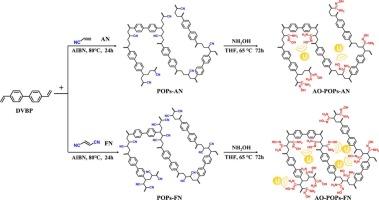Preparation of porous organic polymers via alternating radical copolymerization for uranium adsorption
IF 9.8
1区 工程技术
Q1 ENGINEERING, CHEMICAL
引用次数: 0
Abstract
Meriting from the unique affinity of amidoxime groups towards uranium ions, porous organic polymers (POPs) substituted with cyano groups are promising precursors as high-performance uranium adsorbents. However, their synthesis suffers from harsh conditions, tedious operations, or costly catalysts, which hamper their large-scale utilization. Free-radical alternating copolymerization strategy offers a simple and viable approach to circumvent these bottlenecks with great atomic economy. Here, two electron-withdrawing cyano monomers, acrylonitrile (AN) and fumaronitrile (FN), are successfully integrated with the electron-rich divinylbiphenyl (DVBP) monomer via free-radical alternating copolymerization strategy, forming two family of POPs with tailorable cyano contents. After post-amidoximation, two types of amidoxime-functionalized POPs (AO-POPs) are consequently obtained. Having probed the cyano-induced penultimate effect, it is observed that different feed ratios has regulated the polymerization behaviors, porosities and even adsorption capacities of AO-POPs. Among them, AO-POPs-FN-3, with an appropriate specific surface area and the highest amidoxime content, exhibits the best uranium adsorption capacity (723 mg g−1), along with good selectivity and regenerability. This work demonstrates an environmentally friendly and easy-to-operate free radical copolymerization strategy for the rational design of POPs-based adsorbents and paving for the recycling and sustainable development of uranium resources.

交替自由基共聚法制备吸附铀的多孔有机聚合物
由于偕胺肟基对铀离子具有独特的亲和力,以氰基取代的多孔有机聚合物(POPs)是一种很有前途的高性能铀吸附剂前体。然而,它们的合成受制于苛刻的条件、繁琐的操作或昂贵的催化剂,这阻碍了它们的大规模利用。自由基交替共聚策略提供了一种简单可行的方法,以极大的原子经济性绕过这些瓶颈。本研究通过自由基交替共聚策略,成功地将两种吸电子氰基单体丙烯腈(AN)和富电子二乙烯基联苯(DVBP)单体结合在一起,形成了两个具有可调氰基含量的持久性有机污染物家族。经过后偕胺肟化,得到了两种偕胺肟功能化持久性有机污染物(AO-POPs)。研究了氰化引起的二次效应,发现不同的投料比对AO-POPs的聚合行为、孔隙率甚至吸附能力都有影响。其中ao - pop - fn -3具有合适的比表面积和最高的偕胺肟含量,对铀的吸附能力最好(723 mg g−1),具有良好的选择性和可再生性。本研究为合理设计基于pops的吸附剂,为铀资源的循环利用和可持续发展铺平了道路,展示了一种环境友好、易于操作的自由基共聚策略。
本文章由计算机程序翻译,如有差异,请以英文原文为准。
求助全文
约1分钟内获得全文
求助全文
来源期刊

Desalination
工程技术-工程:化工
CiteScore
14.60
自引率
20.20%
发文量
619
审稿时长
41 days
期刊介绍:
Desalination is a scholarly journal that focuses on the field of desalination materials, processes, and associated technologies. It encompasses a wide range of disciplines and aims to publish exceptional papers in this area.
The journal invites submissions that explicitly revolve around water desalting and its applications to various sources such as seawater, groundwater, and wastewater. It particularly encourages research on diverse desalination methods including thermal, membrane, sorption, and hybrid processes.
By providing a platform for innovative studies, Desalination aims to advance the understanding and development of desalination technologies, promoting sustainable solutions for water scarcity challenges.
 求助内容:
求助内容: 应助结果提醒方式:
应助结果提醒方式:


